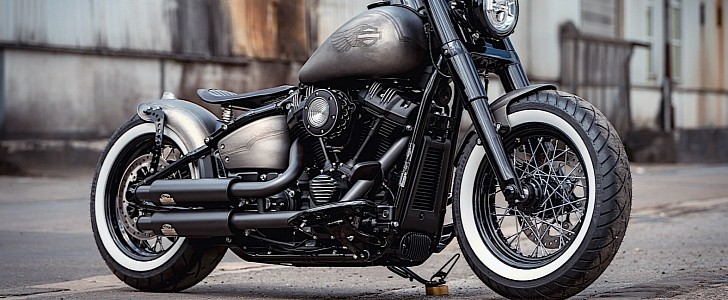Try as you might, you’ll probably have a very hard time imagining soccer (that’s that weird European football) players being fans of Harley-Davidson. These guys mostly seem enchanted by the continent’s most high-profile carmakers, with Ferrari and the likes at the top of their shopping list.
Yet there are exceptions, soccer players that would rather go for two wheels instead of four, and far fewer cylinders. Like this unnamed former star of a German soccer team by the name VFL Bochum, whose most recent project is a Softail-based machine with a beatdown look.
You see, the city of Bochum is heavily tied to mining, and the guys tasked by the soccer player to handle the Softail build, Thunderbike, have done mining-related stuff before, most recently with the Mallet and Iron.
The bike we have here, named by the shop Flying Fur, follows the same general design, with over 30 custom parts fitted in there and wrapped in a special paint job, highlighted by the wings departing from the Harley logo on the fuel tank.
As usual when it comes to Thunderbike builds, the Flying Fury sports lowering kits for the fork and shocks, restyled fenders, a new handlebar, and new wheels – this time, 16-inch pieces in spoked design and wrapped in whitewall tires.
A wealth of other custom bits and pieces, like turn signals, license plate frames, covers all over, or grips have made their way onto the build as well.
Mechanically, not a lot has changed, as far as we can say, apart from the bike’s engine getting a new air filter and a Dr. Jekill & Mr. Hyde exhaust. How these parts affect performance is anybody’s guess.
As for the cost of the build, all the parts used (and listed as such) amount to close to 7,000 euros, which is roughly $8,500 at today’s exchange rates.
You see, the city of Bochum is heavily tied to mining, and the guys tasked by the soccer player to handle the Softail build, Thunderbike, have done mining-related stuff before, most recently with the Mallet and Iron.
The bike we have here, named by the shop Flying Fur, follows the same general design, with over 30 custom parts fitted in there and wrapped in a special paint job, highlighted by the wings departing from the Harley logo on the fuel tank.
As usual when it comes to Thunderbike builds, the Flying Fury sports lowering kits for the fork and shocks, restyled fenders, a new handlebar, and new wheels – this time, 16-inch pieces in spoked design and wrapped in whitewall tires.
A wealth of other custom bits and pieces, like turn signals, license plate frames, covers all over, or grips have made their way onto the build as well.
Mechanically, not a lot has changed, as far as we can say, apart from the bike’s engine getting a new air filter and a Dr. Jekill & Mr. Hyde exhaust. How these parts affect performance is anybody’s guess.
As for the cost of the build, all the parts used (and listed as such) amount to close to 7,000 euros, which is roughly $8,500 at today’s exchange rates.

























